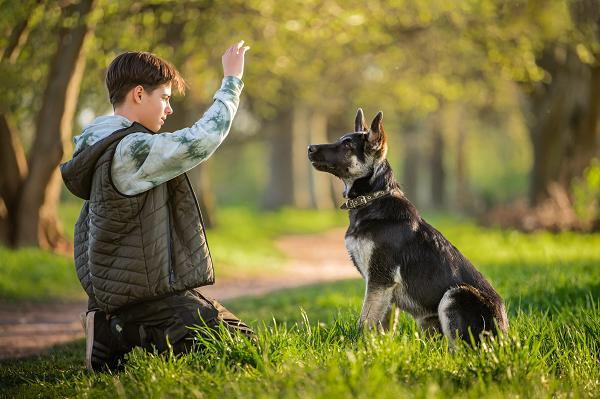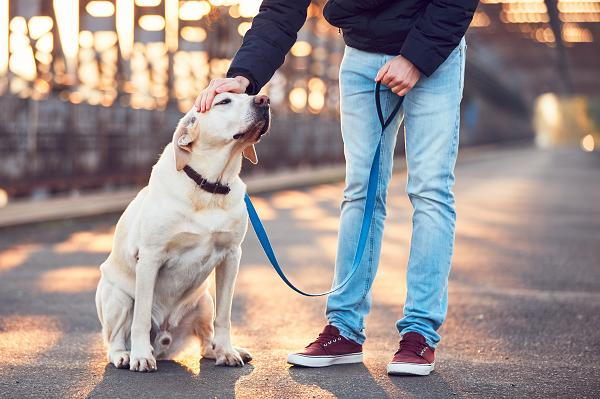
- posted: Jul. 18, 2023
How can I teach my dog new tasks?
- Be positive. Engage in pleasant, positive interactions with your dog.
- Set your dog up to succeed. Sometimes a dog’s first response is not what you want or expect. Consider in advance what behavior you would like your dog to demonstrate. Until training is complete, avoid situations in which your dog is likely to engage in unwanted behavior.
- Reward and praise your dog when they do something right. Monitor the dog’s activity and watch for every opportunity to reward right choices. Food, toys, or praise are common rewards for dogs. Timing is important: rewards need to come immediately after the right behavior.
- Clicker training can be particularly effective at ensuring good timing (see handouts "Behavior Modification – Clicker and Target Training " and "Using Reinforcement and Rewards to Train Your Pet").
- At first, reward every time a desired behavior occurs. Once a desired behavior occurs reliably, intermittent and variable reinforcement can help to maintain the behavior over the long term. If a behavior starts to become less frequent, return to a higher rate of reinforcement and consider consulting a training professional for guidance.
Punishment is not a recommended training strategy. It can have unwanted consequences including fear and aggression. Punishment can permanently damage the trust your dog has in you. Punishment is designed to stop behaviors, but punishment does not inform your dog which behavior to do instead. This can create frustration and confusion.
Be a kind and benevolent leader, much like a parent. Do not try to overpower or threaten your dog.
Behavior modification techniques
Desensitization is a technique in which the intensity of a stimulus is carefully controlled, and is often used to reduce a dog’s fear and arousal in response to a specific trigger. The intensity of the stimulus is low at first so that there is no emotional response. Over time, the intensity is gradually, systematically increased as long as the dog remains comfortable.
If a dog exhibits signs of fear or arousal, then the intensity is too high (see handouts "Introduction to Desensitization and Counterconditioning" and "Overcoming Fears with Desensitization and Counterconditioning").
Counterconditioning is a technique in which a dog is conditioned to relax or feel good. Relaxation training teaches dogs to settle and relax when asked. Since most dogs enjoy food, treats are often used as part of a counterconditioning protocol.
During counterconditioning, when a stimulus that triggers fear or arousal is presented, the dog can be asked to “relax” and/or receive food treats. Counterconditioning thus creates a positive association with the stimulus and can reduce fear.
Counterconditioning is generally paired with desensitization: the intensity of the stimulus is carefully controlled so that the dog does not experience overwhelming fear and can remain relaxed and/or accept food treats.
Response substitution is a technique in which a dog is taught to do a specific, desirable, and incompatible behavior in place of an undesirable behavior. For example, a dog that greets people by jumping on them can be taught to sit to be greeted. The dog cannot simultaneously sit and jump up. Over time, the dog will automatically sit for a greeting.
Training involves communication. Your dog learns to understand your words and signals, and similarly, you learn to recognize your dog’s signals. If your communication is not clear, or if your dog is anxious or frustrated, you may notice some changes in your dog’s posture or body language. It is important to recognize subtle signs of stress or anxiety. Yawning, licking lips, shaking off when not wet, sniffing when there’s nothing to investigate, and looking away are examples of these subtle signs.
If your dog growls, snaps, or bites, then it is important to quietly discontinue the training session. Do not scold your dog for exhibiting these behaviors, as they are your dog’s way of communicating that they are uncomfortable. It is important to seek professional guidance to learn how to safely proceed with training (see handout "Canine Communication – Interpreting Dog Language").
Behavior modification is a gradual process. Do not expect overnight success or a complete cure. Look for improvement in the targeted problem, such as a change in the frequency, intensity, or duration of the behavior. Enjoy the journey with your dog. Daily regimented exercises are not required, but a long-term commitment is.
Contributors: Ellen Lindell, VDM, DACVB; Debra Horwitz, DVM, DACVB, Gary Landsberg, DVM, DACVB, DECAWBM, Theresa DePorter DVM, DECAWBM.
© Copyright 2023 LifeLearn Inc. Used and/or modified with permission under license.
Office Hours
Closed for lunch 12pm to 1pm. For afterhours call 306-378-2252 for the emergency veterinarian on call.
8:00 am - 5:00 pm
8:00 am - 5:00 pm
8:00 am - 5:00 pm
8:00 am - 5:00 pm
8:00 am - 5:00 pm
Closed
Closed

